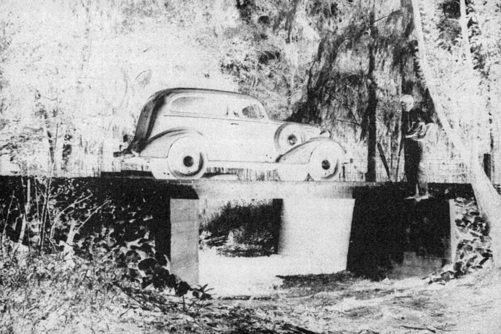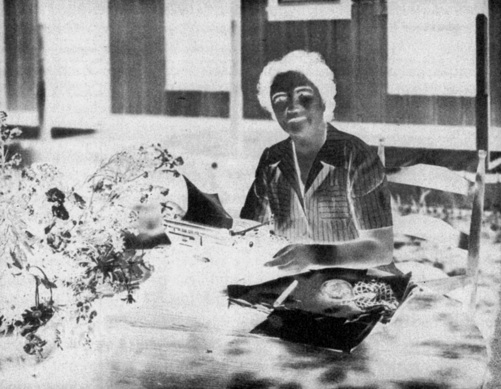The History of Florida (68 page)
Read The History of Florida Online
Authors: Michael Gannon
Tags: #History, #United States, #State & Local, #Americas

324 · William W. Rogers
Picking and crating celery in April 1930 at Sanford, where one-third of the nation’s cel-
ery supply was grown.
others soon transferred the new techniques to the muckland north of Lake
Apopka. By 1940 tomatoes, watermelons, string beans, lima beans, green
proof
peas, cucumbers, peppers, and celery offered significant sources of income.
The Everglades’ persistent flooding problems were eliminated when FERA
and WPA funds were used to build a dike around Lake Okeechobee and
improve the adjacent drainage canals. This work, plus the establishment of
a federal sugarcane experiment station at Canal, made possible the devel-
opment of a lucrative private sugar industry. Corn brought in $4 mil ion
in 1940; it remained an important money crop, as did Irish potatoes, pea-
nuts, velvet beans, and tobacco. The cotton crop of 1940 generated less cash
($1,225,000) than did cabbage ($2,620,533).
Timber was considered a crop, and from it emerged a large pulp paper
industry. The Florida Forest Service (created in 1935), the CCC, and private
individuals launched reforestation programs. At the same time, Charles H.
Henry developed an inexpensive way to manufacture paper from south-
ern slash pine. Cutover land was replanted, and existing forests offered the
possibility of cheap paper products. The decision of the nation’s newspa-
per owners to convert to pulp paper newsprint was especial y important
to Florida. In 1931 the International Paper Company’s operation at Panama
City became Florida’s first mil . Other companies followed, and by the late
The Great Depression · 325
1930s pulp mil s also were operating at Pensacola, Port St. Joe, Jacksonville,
Fernandina, and Palatka. Alfred I. DuPont purchased 70,000 acres of land
in the Gulf counties of Walton, Bay, and Franklin. His Port St. Joe mil ,
opened in 1938 at a cost of $7 million, was the largest in Florida.
The citrus industry expanded. Dating from the establishment in 1909 of
the Florida Citrus Exchange, growers had attempted to formulate industry-
wide policy. The advantages of volume buying and sel ing were advocated by
local exchanges, but many growers preferred independent marketing. Such
practices prevented uniformity of product, and grove owners who shipped
green fruit injured the industry. Improvements came in 1935 when the state
legislature created the Florida Citrus Commission. The agency, which was
financed by a tax on citrus, encouraged growers to ship quality fruit and
engaged in an effective advertising campaign. The state’s share of the 1940
citrus market was impressive: tangerines brought in $1,671,656, grapefruit
$7,637,836, and oranges $25,342,079.
Federal land banks aided Florida’s farmers by providing long-term loans,
and federal involvement in the broad area of agrarian life was profound:
government subsidy payments in 1935 amounted to $1,129,878. AAA agents,
county agents, and various agricultural specialists were funded in part from
Washington. Nathan Mayo, Florida’s commissioner of agriculture, estab-
proof
lished farmers’ markets with New Deal financing. The WPA attempted to
aid Florida’s commercial fishing industry, which rewarded its participants
mostly with hard work and meager incomes. The agency worked out a co-
operative program of replanting and renewing the geographical y limited
industry. The main profits came from oyster beds located along the up-
per Florida coast from Cedar Key in Levy County to Panama City in Bay
County. The shrimp industry soon became an additional means of income.
Changes in farming operations that had long-run benefits were some-
times painful in the short run. As large-scale agriculture became necessary
for economic survival, increased use of machinery diminished the number
of tenant farmers. Although the transition for tenants was difficult, the curse
of sharecropping was ending. Unskilled fruit and vegetable pickers received
low pay for their seasonal work. The migrant laborers followed the harvest
seasons, working the Florida vegetable farms and fruit groves in the fall and
winter and moving north for the spring and summer berries and vegetables.
No labor was more difficult than the relentless leaning over required of cut-
ters in Florida’s sugarcane fields, where charges of peonage occasional y
were raised.
326 · William W. Rogers
New Deal legislation favored union activity, resulting in tense confron-
tation between some owners and workers. A Polk County citrus workers’
union, for instance, met physical opposition. In 1938 the United Cannery,
Agriculture, Packing and Allied Workers of America, a CIO union, struck
over wage reductions. Governor Cone helped to mediate the dispute, which
ended in compromise.
The natural environment, as well as the work environment, was fostered
by governmental action. The national government bought land in north
Florida for the St. Marks Wildlife Refuge and elsewhere added many acres
to the Ocala, Apalachicola, Osceola, and other national forests. The CCC’s
work also had environmental and aesthetic consequences. By the 1930s na-
val stores and logging firms had practical y depleted longleaf yel ow pine
forests, and the timber industry had declined. Profits were low, and opera-
tors kept their black workers in virtual peonage, especial y in the turpen-
tine camps. The turnaround came through reseeding programs led by the
CCC. Many of the twenty-six agency camps were in national forests. In its
nine years in Florida, the agency enrolled more than 50,000 young men in
segregated camps and about $30 million was expended. The CCC planted
13,605,000 trees, cut 14,554 miles of firebreaks, and improved thousands of
acres of forest land. It cooperated with the Florida Parks Service and the
proof
National Park Service to build Torreya State Park and similar projects that
became models for the nation.
In these and other ways the New Deal left an indelible mark on Florida.
The WPA’s public works projects continued into the early 1940s. Florida led
the nation in WPA airport construction. Tampa benefitted, for example,
by expansion of its airport and construction of a large dry dock. Statewide,
the WPA built 800 public buildings and constructed bridges, roads (more
than 6,000 miles), culverts, parks, playgrounds, athletic fields, public hous-
ing, and hospitals. It conserved beaches against erosion, built seawal s, and
helped complete the intracoastal waterway. Artists, writers, sculptors, musi-
cians, and teachers were funded in their work. The Federal Writers’ Project
employed historians and others to collect public records, and an excellent
guide to Florida was compiled. The Federal Theatre’s productions at Miami,
Jacksonville, and Tampa, plus its statewide touring company, employed out-
of-work actors, playwrights, and stage personnel.
In 1935, Key West became a monument to federal-state-local coopera-
tion. Bankrupt, and with 80 percent of their citizens on relief, local officials
asked the governor to declare a state of emergency. His decree authorized
the FERA to take over the city. By those means Key West was revitalized,

The Great Depression · 327
The Civilian Conservation Corps (CCC), the first New Deal agency to operate in Florida,
began at Eastport in Duval County in 1933. Before its termination in 1942, the CCC gave
work to more than 50,000 Floridians between the ages of eighteen and twenty-five.
Though best known for planting millions of trees and clearing thousands of miles of
firebreaks, the agency also helped to establish wildlife preserves and numerous state
proof
parks, including Hillsborough near Tampa and O’Leno near High Springs. In the pho-
tograph, a CCC official is shown in September 1936 inspecting a bridge and road fill
constructed at O’Leno State Park.
as citizens contributed long hours to cleaning streets, developing beaches,
renovating houses and hotels, and improving sanitation facilities. New Deal
funds enabled the town to become a bustling resort city, aided by construc-
tion of a highway to the mainland, 100 miles away. The project was threat-
ened when disaster struck on Labor Day, 2 September 1935. A hurricane
slashed the Keys, where about 400 lives were lost. Henry Flagler’s Over-
seas Railroad, completed in 1912, was so badly damaged that it was sold to
the state. With federal and state assistance, the Monroe County Toll Bridge
Commission took it over, and U.S. Highway 1 was completed to Key West in
1938.
At the state level, the State Board of Public Welfare, backed by Governor
Sholtz, concerned itself with a broad range of social problems, including
child welfare. After 1935, when state participation in relief programs in-
creased, the board enlarged its operations and in 1937 became the Depart-
ment of Social Welfare. Sholtz pushed the state toward a greater role but
328 · William W. Rogers
was restrained when the state supreme court declared unconstitutional his
attempt to pledge Florida’s credit on a loan. Sholtz persisted, and in 1935 the
state allocated $2 million toward its responsibility for the welfare program.
Tax revenues were to be applied to relief payments (this required the suc-
cessful passage of a constitutional amendment), for schools, for the State
Welfare Board, and for a State Planning Board.
After 1935, Florida evolved past its traditional status as a small-govern-
ment state. The forces of change were inexorable, and the result was in-
evitable: complex, complicated government on a scale necessary to meet
the needs of a growing state. The trend took on momentum as the eco-
nomic situation improved toward the end of the Sholtz administration and
throughout that of Governor Cone. Setbacks occurred, but the line on the
prosperity graph was upward. Floridians welcomed a constitutional change
that authorized a homestead tax exemption. State government action and
recovery were further aided by the Murphy Act. The col apse of the 1920s
land boom had left much real estate abandoned and subject to delinquent
taxes. Cone wanted taxes collected and homesteads settled on the lands. In
1937, the Murphy Act allowed the sale of tax-delinquent land for tax certifi-
cates, whereby shrewd buyers obtained deeds at a fraction of land value. The
public gained by having the land restored to the tax rol s.
proof
Tourism and its economic benefits experienced renewed vigor. The num-
ber of tourists had dropped to a half million in 1932, but a comeback was
evident by 1934. The 2 million who came in 1935 created the largest tourist
season in state history, and Floridians welcomed the $625 million they left
behind. In 1936, the
Tampa
Tribune
boasted that tourism “is our richest
crop. . . . It rides in and rides out, leaving its money as it goes.”7 Build-
ing permits for hotel and residential construction had dropped to less than
$400,000 in 1932—one real estate developer was reduced to advertising five-
acre farms for $60 each—but in 1936 building permits exceeded $9 million,
and on Miami Beach’s Collins Avenue a line of Art Deco hotels rose from
the sand.
Commercial aviation, begun in the 1920s, expanded. By 1939 Florida had
three scheduled airlines: Pan American, Eastern, and National. Adding to
the growing private freight and passenger service was the decision of the
Army Air Corps to train many of its pilots in Florida. By 1940 Army and
Navy airfields were established at Miami, Tampa, Orlando, Jacksonvil e,
Pensacola, Valparaiso, and Arcadia. Others fol owed as military aviation
became a major industry.

